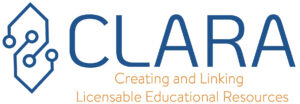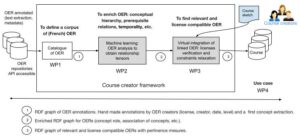Abstract
CLARA project aims to empower teachers to facilitate the creation of licensable educational resources based on existing ones. Our approach will suggest a relevant set of educational resources (ER) such that these are coherent with a course sketch and have compatible licenses. The main challenges we will face are how to enrich a network of ERs using AI algorithms, and how to guarantee a minimal set of license-compatible ERs relevant to a given course goal with query relaxation techniques. We will exploit ERs provided by the French Ministry of Education and the X5-GON project.
Scientific goals and key challenges
Our work in CLARA aims to allow teachers define a sketch of a new course from which we will suggest a set of relevant ERs for her course. There are plenty of licensed and reusable educational resources that can not be discovered because they are not well connected. Machine-readable semantic annotations will help link and enrich educational resources thanks to well-known ontologies. Semantic matches will provide considerable added value when searching relevant resources. In addition, we aim to go further by connecting resources through links identified by AI algorithms.
Most of the works using semantic web technologies propose tools to support learners with personalized learning, adaptive educational content, facilities for collaboration, etc. Few works assist teachers to find relevant educational resources, and to the best of our knowledge, there is no solution to help teachers create courses by reusing existing ones while preserving licenses and proposing a license able to protect their courses.
Our main goals are the following, cf Figure 1.
- To build a corpus of linked ERs by collecting and organizing catalogs of existing educational resources. We target a rich and semantic representation of available metadata to identify, licenses, similarities, dependencies or other connections between the ERs.
- To enrich the semantic annotations by connecting resources through links identified by machine learning algorithms like concepts, the hierarchy of concepts, prerequisite relations, the temporality of concepts, etc.
- To design a query engine that facilitates finding license-compatible educational resources
relevant to a given course sketch.
Figure 1: CLARA framework
We will use semantic web standards and recent specifications (OWL, RDF, RDF-star, SPARQL) to integrate our results and contributions to construct a knowledge graph of enriched and linked educational resources. Recently, some ontologies have been defined to structure semantic annotations for educational resources. We will use, for instance, the Teaching Core Vocabulary for courses, CCSO for syllabus, the LOM (Learning Object Metadata) standard to structure the educational resources, etc.



